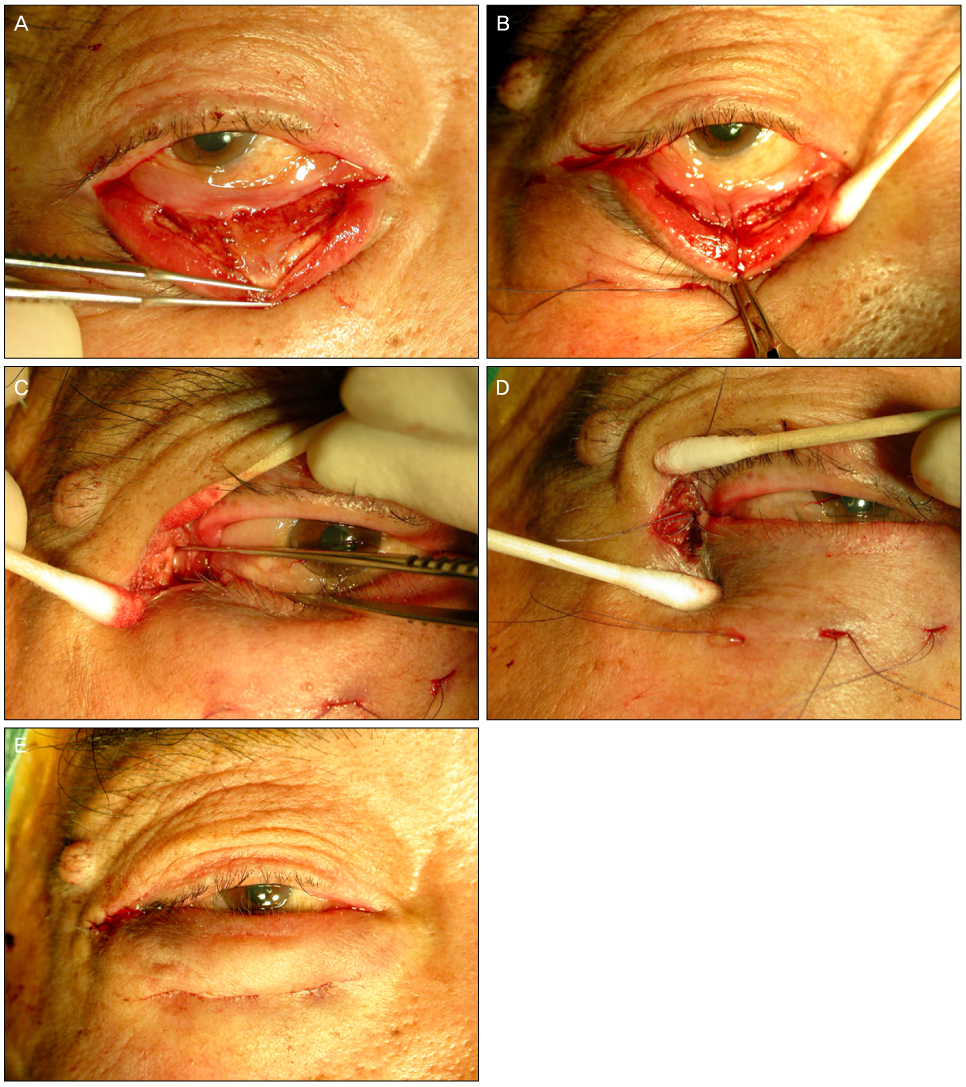J Korean Ophthalmol Soc.
2012 Feb;53(2):187-192.
Involutional Ectropion Repair with the Modified Medial Spindle and the Lateral Tarsal Strip Procedure
- Affiliations
-
- 1Department of Ophthalmology, Wonkwang University College of Medicine, Iksan, Korea. sangduck@wonkwang.ac.kr
Abstract
- PURPOSE
To evaluate the effects of the modified medial spindle and the lateral tarsal strip procedure in involutional ectropion patients.
METHODS
The lateral tarsal strip procedure with the modified medial spindle procedure that adjusts the size and the position of the spindle along the severity of lower eyelid eversion was performed on 17 eyes of 12 patients with involutional ectropion. The average follow-up period was 19.6 months.
RESULTS
All 12 patients were male, and the mean age was 65.4 years (range 54 to 78 years). There was no recurrence in any of the 17 eyelids. However, a mild lower lid retraction and a mild punctal eversion not requiring reoperation occurred in the follow-up period.
CONCLUSIONS
The lateral tarsal strip procedure combined with the modified medial spindle appears to be effective in the surgical treatment of involutional ectropion.
Figure
Reference
-
1. Collin JRO. A Manual of Systematic Eyelid Surgery. 1989. 2nd ed. Edinburgh: Churchill Livingstone;27–40.2. Levine MR. Manual of Oculoplastic Surgery. 2010. 4th ed. Thorofare, NJ: SLACK;173–182.3. Bashour M, Harvey J. Cause of involutional ectropion and entropion - age-related tarsal changes are key. Ophthal Plast Reconstr Surg. 2000. 16:131–141.4. Smith B. The "lazy-T" correction of ectropion of the lower punctum. Arch Ophthalmol. 1976. 94:1149–1150.5. Della Rocca DA. The lateral tarsal strip: illustrated pearls. Facial Plast Surg. 2007. 23:200–202.6. Anderson RL, Gordy DD. The tarsal strip procedure. Arch Ophthalmol. 1979. 97:2192–2196.7. Stefanyszyn MA, Hidavat AA, Flanagan JC. The histopathology of involutional ectropion. Ophthalmology. 1985. 92:120–127.8. O'Donnell B. Age-related medial entropion of the lower eyelid. Aust N Z J Ophthalmol. 1994. 22:183–186.9. Fong KC, Mavrikakis I, Sagili S, Malhotra R. Correction of involutional lower eyelid medial ectropion with transconjunctival approach retractor plication and lateral tarsal strip. Acta Ophthalmol Scand. 2006. 84:246–249.10. White WL, Woog JJ. Albert DM, Jacobiec FA, editors. Lower eyelid malpositions. Principles and Practice of Ophthalmology [book on CD-ROM]. 1995. 49. Philadelphia: WB Saunders;596–693.11. Wright KA. Congenital eyelid anomalies, eyelid malpositions, and blepharoptosis. Interactive ophthalmology on CD-ROM-textbook and review. 1997. Baltimore: Williams & Wilkins;5191–5326.12. Nerad JA. Nerad JA, editor. The diagnosis and treatment of ectropion. Oculoplastic Surgery. The Requisites in Ophthalmology. 2001. St. Louis: Mosby;71–88.13. Wesley RE. McCord CD, editor. Ectropion repair. Oculoplastic Surgery. 1995. 3rd ed. New York: Raven;249–261.14. Putterman AM. Ectropion of the lower eyelid secondary to Muller's muscle-capsulopalpebral fascia detachment. Am J Ophthalmol. 1978. 85:814–817.15. Wesley RE. Tarsal ectropion from the detachment of the lower lid retractor. Am J Ophthalmol. 1982. 93:491–495.16. Nowinski TS, Anderson RL. The medial spindle procedure for involutional medial ectropion. Arch Ophthalmol. 1985. 103:1750–1753.17. Tse DT, Kronish JW, Buus D. Surgical correction of lower eyelid tarsal ectropion by reinsertion of the retractors. Arch Ophthalmol. 1991. 109:427–431.18. Shah-Desai S, Collin R. Role of the lower lid retractors in involutional ectropion repair. Orbit. 2001. 20:81–86.19. Frueh BR, Schoengarth LD. Evaluation and treatment of the patient with ectropion. Ophthalmology. 1982. 89:1049–1054.
- Full Text Links
- Actions
-
Cited
- CITED
-
- Close
- Share
- Similar articles
-
- Lateral tarsal strip operation for the correction of paralytic and involutional Ectropion in Sorokdo Leprosy Patients
- Clinical Effectiveness of the Lateral Tarsal Strip Procedure
- Reappraisal of the lateral tarsal strip in the treatment of paralytic ectropion
- Lateral Tarsal Strip Procedure Combined with Quickert Sutures in Correcting Involutional Entropion
- Severe Upper and Lower Tarsal Ectropion with Immunoglobulin G4-related Ophthalmic Disease



